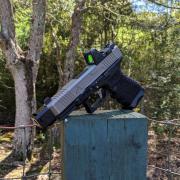So while I'm waiting for my plate to get here I decided to try a highly unscientific experiment.
I took two spare Glock plate screws, and one of the Glock MOS plates I wasn't using. I chased the screws and cleaned the threads up. I then installed both on the plate, one using Vibratite VC-3 (V) and one using some Versachem "245" blue (medium strenth, similar to Loctite 243, so call that one (L)). I've used this tube of 245 the past four years on Glock front sight posts with no issues.

The (V) screw I prepped according to the directions. One drop, then allowed to dry 30 minutes. Then installed.
The (L) screw i put the blue threadlocker on just like I normally do on a sight post (just a bit) and installed it wet. It's curing now. I torqued both to 10 inch lbs using my Wheeler FAT gauge.
Couple observations. The (V) screw head seemed to go in fine, but there is a large amount of the polymer VC-3 residue that pooled up around the screw head. Also, I reread the instructions for my Wheeler and was surprised how tight 10 inch lbs actually is, when set to the red mark and torqued. Wheeler recommends a click, then two clicks past, to "set" the torque value. These tiny screws are pretty tight.
My tool arrived with a Calibration sheet indicating a set 10 inch lbs was an actual value of 9.6 in lbs, at least according to their metrology source at the Wheeler factory (probably somewhere in China, I reckon.) Close enough.
Anyway, I'll undo these tomorrow to see how they compare in loosening up, and post back anything interesting.




 Reply With Quote
Reply With Quote




